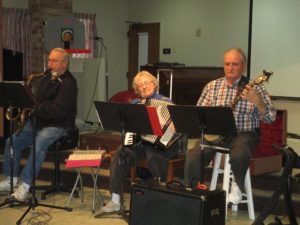
Recently, the Community Village residents came out to listen to the music of the “Second Time Around”. What an enjoyable afternoon singing along, clapping and dancing in their seats!
Updates
Practical Help for Families
Knowing where to turn for help.
Some things in life we just don’t consider until we’re forced to do so. Dealing with the realities of an aging parent is one of those things. It can be confusing, emotional, and frustrating. However, there are resources available to help you make sense of the options and decisions that lay ahead. Research the ones that will help you specifically.
Working together as a team.
Best case scenario is that you have willing family members involved in the process. Even if you don’t, create a team including your parent’s physicians, trusted family or friends, and, of course, your parent. The hard conversations will need to happen; be gentle with yourself and with others.
Establishing objectives.
When managing the transition, it’s advantageous that everyone involved aligns their objectives to what will keep your parent safest and happiest. Though each person might define that differently, starting this conversation is the first step forward.
Recognizing your parent’s needs and limitations.
Taking action – actually relocating your parent – is often preceded by months of observations and concerns that you might not be ready to accept. Is this normal? Am I exaggerating what just happened? Rather than question yourself, become familiar with How to Know When It’s Time for Help.
Activities of Daily Living
Routine activities that people tend to do every day without assistance are referred to as Activities of daily living (ADL).
Basic Activities of Daily Living (ADLs)
- Eating: chewing, swallowing, drinking
- Bathing and showering
- Personal hygiene and grooming: brushing, combing, styling hair
- Dressing
- Toilet hygiene: getting to the toilet, cleaning oneself, and getting back up
- Functional mobility (also called “transferring”): walking, getting in or out of bed, sitting down or standing up
Hierarchy to the ADLs: hygiene, toilet use and locomotion, eating.
Instrumental Activities of Daily Living (IADLs)
- Cleaning and maintaining the house
- Managing money
- Moving within the community
- Preparing meals
- Shopping for groceries and necessities
- Taking prescribed medications
- Using the telephone or other form of communication
Though IADLs are not necessary for fundamental functioning, they allow the individual to live independently within a community.
Bristol Activities of Daily Living Scale is a tool to help you assess your parent’s current independence.
Daily Nutrition for Seniors
As we age, sense of taste and smell can change, foods may become less flavorful. Medications can both affect how food tastes and can diminish appetite. Some people become lactose intolerant or have foods that disagree with them in other ways. Others have difficulty chewing food because their gums are sore or their dentures don’t have a good fit. With each of these challenges, it’s important to find ways to maintain daily nutrition intake required for healthy senior living.
The National Council on Aging recommends:
Eat a variety of foods to get all the nutrients you need. Your plate should look like a rainbow—bright, colored foods are always the best choice! A healthy diet should include:
- Lean protein (lean meats, seafood, eggs, beans)
- Fruits and vegetables (think orange, red, green, and purple)
- Whole grains (brown rice, whole wheat pasta)
- Low-fat dairy (milk and its alternatives)
- Foods that are high in fiber and low in sodium or salt
- Vitamin D as this is an important mineral for aging
- Plenty of water! Drink small amounts of fluids consistently throughout the day. Tea, coffee, and water are your best choices. Keep fluids with sugar and salt at a minimum, unless your doctor has suggested otherwise.
The American Heart Association provides recommended daily servings for adults aged 60+.
The USDA offers a simple way to help people see what they should eat each day called MyPlate.
Recommended Packing List
Familiarizing yourself with the amenities provided by your care facility will aid in creating your specific packing list.
What to Bring with You
- Bed – we provide a bed, dresser and nightstand, but you are welcome to bring your own if you choose
- Laundry Basket
- Clothing – mostly comfortable clothing that doesn’t require dry cleaning. Some dressy items would be nice for special events and holidays. Please label all clothing with resident name.
- Clothes Hangers
- Shoes, socks, slippers
- Furniture as needed (chair/recliner)
- TV, radio, stereo
- Telephone and/or cell phone with charger
- Assistive devices – eyeglasses, hearing aids, dentures, canes, walkers, etc.
- Personal Items & Toiletries – toothpaste, toothbrush, denture products, comb, brush, soap, shampoo, shaving products, incontinence supplies
- Decorative items – artwork, wall hangings, clock, photos, houseplants
- Personal computer, laptop or electronic tablet
- Playing cards, board games, hobby items
- Books and other reading material
What Not to Bring to Assisted Living
- Rugs
- Collectables
- Large furniture sets
- Kitchen items

